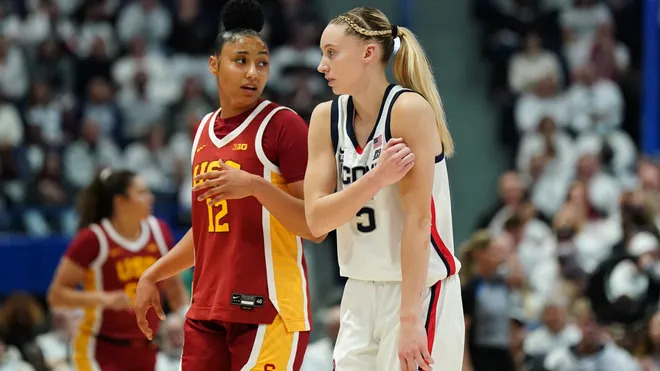UConn graduate guard Paige Bueckers and USC sophomore guard Juju Watkins have helped grow the popularity of women’s basketball. Photo courtesy of USA Today.
BROCK DANAHEY | STAFF REPORTER | bldanahey@butler.edu
Overtime, or “OT,” is an opinion column series where the Collegian takes national sports headlines or polarizing topics and gives them a Butler-centric angle.
March Madness is in full swing for both the men’s and women’s tournaments. Last year’s tournament was the first time in history that the women’s championship had more viewership than the men’s.
The 2024 women’s championship between South Carolina and Iowa averaged 18.7 million viewers and peaked at 24 million, making it the most watched college women’s basketball game ever. The men’s championship between UConn and Purdue averaged 14.82 million viewers.
Even though the women’s tournament continues to increase in popularity, there are still some major differences between it and the men’s tournament.
The most obvious disparity is that the entire men’s tournament is played at neutral sites, while the women’s hosts games at the home court of the top four seeds in each region.
For example, in the first round, the defending champs, one-seed South Carolina, defeated 16-seed Tennessee Tech, while eight-seed Utah lost to nine-seed Indiana. South Carolina went on to beat Indiana by double digits in the second round. Each of these games was played at Colonial Life Arena on South Carolina’s campus.
If any team wants to upset a top seed in the women’s tournament, they have to do so on that team’s home floor with a packed arena of fans cheering against them. All of those factors combined make it a tall task for some of the underdog teams who earn a bid into the tournament.
This layout of the current tournament began in 2015 when the NCAA made an effort to boost attendance after neutral court sites had lackluster ticket sales.
Attendance at games has improved, with a record 292,456 fans attending first and second round games in 2024.
UConn head coach Geno Auriemma and Indiana head coach Teri Moren have been two of the most vocal in criticizing the current format. They have talked about how difficult it is for the underdog to go on the road and knock off a top seed in March Madness.
Junior sports media major Graham Landt thinks home court advantage is not the only thing preventing lower seeds from advancing in the tournament.
“I see a difference where the strongest seeds in women’s basketball tend to always advance,” Landt said. “There are much less upsets in my opinion. The skill gap seems to be a lot bigger between the higher seeds and the lower seeds in women’s basketball, where there are a lot more blowouts.”
Since the women’s field expanded to 64 teams in 1994, No. 14 through No. 16 seeds are a combined 1-372 in the tournament. That lone win came in 1998 when No. 16 Harvard upset No. 1 Stanford.
Since 1985 when the men’s field expanded to 64 teams, No. 14 through No. 16 seeds are 36-452 in March Madness. Even though it’s a larger sample size, there have been significantly more Cinderella stories in the men’s tournament.
So far in this year’s men’s tournament, the higher seed has defeated the lower seed a total of 11 times through the first two rounds. That’s only happened seven times in the women’s bracket.
Junior accounting major Sean Grove has attended both women’s and men’s March Madness games. He thinks having the top four seeds playing the first two rounds at home is best for the game.
“I think there is a charm in having the top seeds play at home for the first two rounds,” Grove said. “More tickets will be sold. To be honest, you want the one through four seeds in the Sweet Sixteen anyway.”
Viewers tune into March Madness to watch the stars of the game, who are typically playing for powerhouse teams like South Carolina, UConn or LSU. The more these teams win, the more people will tune in to watch the best players in the game.
Dr. Mindy Welch, an associate professor in the College of Education, thinks a gradual change to all neutral sites would be best for the women’s tournament.
“Maybe they could layer it in,” Welch said. “Instead of the top four, they could give home court advantage to the top eight seeds. I don’t know what the barriers are, but just from a pure equitable perspective, why not?”
The lowest seed to ever win the women’s tournament was a No. 3 seed — most recently accomplished by LSU in 2023. Meanwhile, No. 10 through No. 16 seeds have never made it past the Elite Eight.
In the men’s tournament since 1985, seven double-digit seeds have made it to the Final Four. The lowest seed to win the tournament was No. 8 Villanova in 1985.
The top seeds in the women’s tournament are the best for a reason. They do not need the added advantage of home court. Let’s make some changes and have some more Cinderella stories in women’s March Madness.



